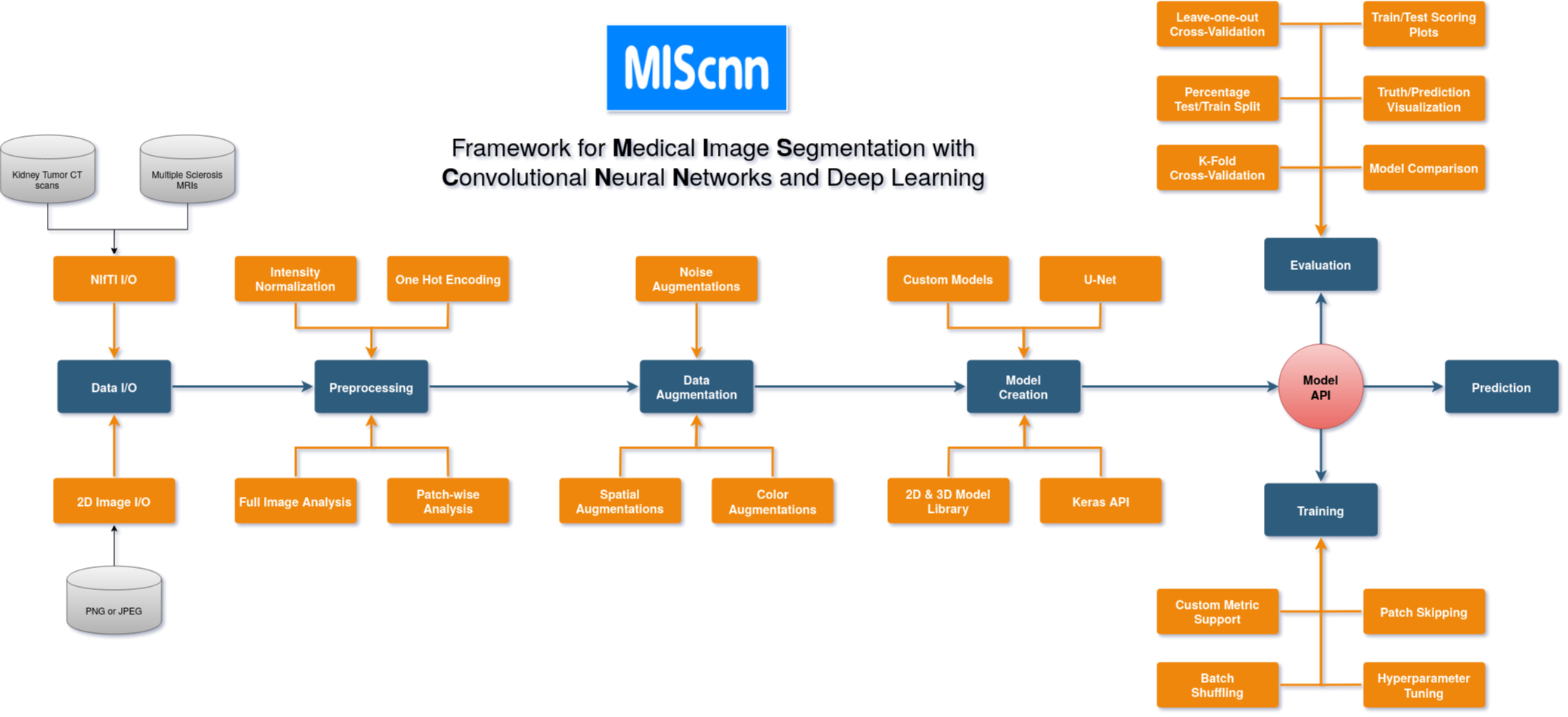Framework for Medical Image Segmentation with Convolutional Neural Networks and Deep Learning
Project description
MIScnn: Medical Image Segmentation with Convolutional Neural Networks
The open-source Python library MIScnn is an intuitive API allowing fast setup of medical image segmentation pipelines with state-of-the-art convolutional neural network and deep learning models in just a few lines of code.
MIScnn provides several core features:
- 2D/3D medical image segmentation for binary and multi-class problems
- Data I/O, preprocessing and data augmentation for biomedical images
- Patch-wise and full image analysis
- State-of-the-art deep learning model and metric library
- Intuitive and fast model utilization (training, prediction)
- Multiple automatic evaluation techniques (e.g. cross-validation)
- Custom model, data I/O and metric support
- Based on Keras with Tensorflow as backend
Getting started: 30 seconds to a MIS pipeline
Create a configuration object to adjust settings as needed.
from miscnn.configurations import get_options
# Create configuration object with default settings
config = get_options()
# Adjust input parameters
config["data_path"] = "/home/muellerdo/MRIs_KidneyTumor/"
config["data_io"] = "nifti"
# Adjust model parameters
config["classes"] = 3
config["dimension"] = "3D"
config["architecture"] = "unet"
config["model_variant"] = "standard"
# Adjust training parameters
config["epochs"] = 40
# Adjust prediction parameters
config["output_path"] = "predictions/"
Create a neural network model with adjusted configurations.
import miscnn.neural_network
model = miscnn.neural_network(config)
Run a training pipeline including data I/O, preprocessing and data augmentation with default settings.
training_set = list(range(0, 100))
model.train(training_set)
Run a prediction pipeline and save results under "predictions/".
prediction_set = list(range(100, 150))
model.predict(prediction_set)
Installation
There are two ways to install MIScnn:
- Install MIScnn from PyPI (recommended):
Note: These installation steps assume that you are on a Linux or Mac environment. If you are on Windows or in a virtual environment without root, you will need to remove sudo to run the commands below.
sudo pip install miscnn
- Alternatively: install MIScnn from the GitHub source:
First, clone MIScnn using git:
git clone https://github.com/frankkramer-lab/MIScnn.git
Then, cd to the MIScnn folder and run the install command:
cd MIScnn
sudo python setup.py install
Author
Dominik Müller
Email: dominik.mueller@informatik.uni-augsburg.de
IT-Infrastructure for Translational Medical Research
University Augsburg
Bavaria, Germany
How to cite / More information
Dominik Müller and Frank Kramer. (2019)
MIScnn: A Framework for Medical Image Segmentation with Convolutional Neural Networks and Deep Learning.
License
This project is licensed under the GNU GENERAL PUBLIC LICENSE Version 3.
See the LICENSE.md file for license rights and limitations.
Project details
Release history Release notifications | RSS feed
Download files
Download the file for your platform. If you're not sure which to choose, learn more about installing packages.












